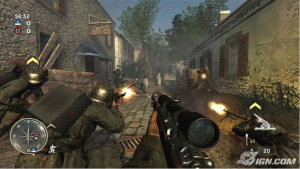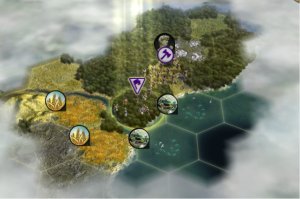The following is a guest post from Jamie Taylor. Jamie is currently an Interpretation Developer at The National Railway Museum in York, UK. He is especially interested in how procedural rhetoric can be used in the practise of history and how ‘interesting decisions’ can help facilitate counterfactual narratives. You can follow him on twitter @theboywholefthome.
Serious games for the serious work of history?
‘The culture at large’ as Katie Salen and Eric Zimmermann note ‘does not yet see games as a noble, or even particularly useful endeavour.’ Since those words were written in May 2003, there has been a marked transformation in the esteem with which digital games are regarded. As Benjamin Devane comments ‘Once reviled for changing young people into anti-social and potentially violent lay-abouts, games are now praised for their capacity to transform peoples’ learning practices.’ In part this rehabilitation can be traced through the rise of the serious game. Serious games, as Ute Rittefeld, Michael Cody and Peter Vorderer argue, focus on ‘deeper learning in the context of an enjoyable experience.’ They are games that have been ‘developed with the intention to be more than entertainment.’ They aim to achieve the holy grail of pedagogy by taking the discomfort out of learning through masking it with play. As Elly Konijn and Marye Nije Bijvank note ‘play offers possibilities to experience the execution of developmental tasks without being aware of the developmental goal.’ Thus games allow for learning by stealth.
Serious games have been utilized in an increasing field of activities including politics, advertising and education. In effect, serious games can be said to be moving the realm of play into areas that are widely considered as serious. The rehabilitation of digital games can also partly be attributed to a move in the opposite direction; the movement of the serious into the realm of play. No more is this in evidence than in the increased use of history as a backdrop to mainstream gaming titles. These games aim primarily to be fun yet, in an effort to appeal to a more adult audience, often come complete with claims of historical authenticity. These titles will often employ qualified academics to research content and advise developers or will come bundled with encyclopaedic background material in which the player is encouraged to contextualize their in-game experience. The genre of historically themed games has become so sophisticated that Adam Chapman proposes his hope ‘that by now few deny that contemporary games series like Civilization or Assassin’s Creed constitute history.’
Yet can we be sure that this argument is so definitively settled? Certainly the agency within digital games poses a problem. The player’s freedom of choice to essentially re-write history and create scenarios that did not happen opens digital games to the charge that they are simply a fiction. William Uricchio notes that ‘if we take interactivity to be one of the distinguishing characteristics of computer games, the interaction between a present-day player and the representation of a historically specific world would seem to challenge any notion of a unique configuration of historical “fact” and “fixity,” giving way instead to the historically inconsistent and ludic.’ Jerome de Groot is particularly sceptical about what value digital games can bring to history. In discussing popular ‘first person shoot ’em up’ (FPS) titles such as Call of Duty de Groot claims that ‘History in these games has become a masculine backdrop to a leisure activity’ and that there is ‘nothing to be learned from this type of history, no information to be gleaned’. Indeed, he argues that what is presented by this type of game is potentially misleading; a type of ‘historical amnesia, effacing the complexities of the situation in order to present a heroic sweeping narrative teleology.’

The ludic structure of games can also pose a problematic characteristic that challenges the authenticity of the history on offer. Games depend on rules and the completion of tasks to advance. As such, the environment presented in digital games is limited within this. This confinement narrows the historic experience, focusing the player on only those actions that are required to win the game. ‘[T]his history’ as de Groot notes, ‘won’t move onwards without the player satisfying certain criteria, eliminating the correct enemies and staying alive.’ Thus, he argues what is presented in this type of game is not a narrative history but rather a simulation in which the player has an ‘illusion of control’. This simulative effect, he concludes, leads to an experience of history that is ‘fragmented, ontological and particularized.’
History as it can be played
If we see history as a discipline that is forged within the academy, digital games stand as something separate. For all of their aspirations of authenticity and authority, historical games, no matter how much research goes into them, are subject to the commercial demands of the development studio. To achieve success, the game must often bow to the demands of achieving a playful experience; historical accuracy can only ever come second. Games are not subject to the same rigorous standards and the process of peer review with which academic history is judged. Andrew B.R Elliot and Matthew Wilhelm Kapell note this conflict when they state,
history is designed with the goal of knowledge, understanding and enlightenment in mind; video games are designed to be played. As a result, playability can be seen to overpower historicity.
This, however, is not to say that digital games should not be considered as history. Indeed, many games do not require or aspire to such authenticity. In the context of a digital game is authenticity even relevant? Chapman argues that historic digital games should be judged on ‘their own terms’. To do otherwise and to criticize games for their lack of historical accuracy, Chapman argues, is to fall victim to an ‘ontological discrepancy whereby the nation of “accuracy” or “truth” is collapsed with and thus taken to mean, “in alignment with the narrative of book history.”‘ He argues, just as the history presented in books is the representation of the past as it can be written, so too the representation of the past in games is history as it can be played.
Dinner whichever way you look at it.
Chapman’s point is interesting in that it echoes the debate around public history. If something does not look like academic history, or smell like academic history, does this somehow denigrate its worth as history? It is this debate that Raphael Samuel took up in Theatres of Memory. Through his great itinerary of popular historic expressions, he argued that there are a multitude of ‘invisible hands’ shaping history and that each makes part of a wide and varied historical landscape. That while each has its own qualities; they all contribute to historical knowledge in different and equally valid ways. If we see history ‘as an activity rather than a profession’ could we not add the game programmer or graphic designer to Samuel’s pantheon of ‘unofficial sources of historical knowledge’? If indeed Rowan Atkinson is deserving of ‘as much attention as the holder of a Regius Chair’ is not then Sid Meier? When we begin to see the representation of the past in games as just one of many possible ways of expressing history, we begin to see the folly of dismissing it on account of its difference to that which is produced in books.
It is this idea of history ‘as an activity’ that places the debate around games, not just in the field of history but also in the wider sphere of public history. For, if we see history as an activity rather than a product of the historian’s labours we are immediately presented with a more democratic and inclusive subject. No longer with history as an activity are we so reliant on the professionally trained historian to produce a product, as we can do it ourselves. History is opened to the public.
Elliott and Kapell attempt to get to the most basic elements of what constitutes history. What they find is indeed, not a product but instead a process. As their starting point they quote a key passage from What is History by E.H Carr. In it Carr claims that,
History consists of a corpus of ascertained facts. The facts are available to the historian in documents, inscriptions and so on, like fish on a fishmongers slab. The historian collects them, takes them home, and cooks them and serves them in whatever style appeals to him.

Through this analogy they argue that history, at its most basic is the ‘process of selection, assembly, and presentation’. Thus anyone who chooses to both reference and represent the past through this process can be seen as producing history. When seen as such, Chapman proposes that ‘the simple markers that we would expect to see within any history, regardless of form, are all present in the historical videogame.’ In deciding what will populate the ‘specific spatio-temporal setting for play to take place within’ we can detect the developers’ process of selection. By recognizing that these pieces work together to create meaning we can see ‘the beginnings of narrative construction’ and thus evidence of assembly. Finally, by making a choice on the style of game (FPS, turn based strategy etc.) the developer is ‘making the first epistemological decision about the approach that the game will take to the evidence’ and thus its presentation. Returning to Carr’s analogy, the historian may take a range of ingredients and serve us a fish pie. The games designer may take those same ingredients but instead serve us with fish and chips. Both different dishes but dinner nevertheless.
Games as counterfactual history
If we accept games as facilitating a different type of history, we begin to see the fascinating possibilities they present to us. Through the agency they afford the player, digital games allow for first hand experiences of processes and decision-making. While this can be viewed as their greatest weakness, it can also be seen as their greatest strength. By setting rules and mimicking constraints, digital games can represent the choices and consequences faced by actors from the past. As Elliot and Kapell note,
the ludic capacity of historical video games allows for an in-depth understanding not just of facts, dates, people or events, but also of the complex discourse of contingency, conditions and circumstances which underpins a genuine understanding of history.
While traditional historical practices may allow us to understand these decisions, games also allow the subject the opportunity to make them. As Uricchio notes, while print media fixes a particular representation of the past, games media, while ‘offering some fixed elements and underlying principles’ instead thrives upon ‘the creative interaction of the user.’ Where some may argue that this is liable to create fiction, others may see opportunities for radical counterfactual histories. As Hugh Trevor-Roper argues, the value in doing so is considerable,
At any given moment in history there are real alternatives … How can we ‘explain what happened and why’ if we only look at what happened and never consider the alternatives … it is only if we place ourselves before the alternatives of the past … only if we live for a moment, as the men of the time lived, in its still fluid context and among its still unresolved problems, if we see those problems coming upon us … that we can draw useful lessons from history.

Thus, it can be argued that digital games allow for a different type of historical understanding. This is an understanding not simply based on facts and figures, but rather on an understanding of process. It puts the player in the position of a historical agent and asks “given the circumstances, what would you do?” It is this ability to offer a choice and investigate the consequences that sets games media apart from traditional historical practice.
This ability to choose can be seen as a great democratising force. Counterfactual’s imperative to ‘invent! imagine! create!’, as Uriccho notes, mirrors a post structural history which embraces ‘representational uncertainty’, challenges ‘established explanatory master narratives’ and asserts bold and articulate ‘partial histories, histories embedded in a clearly defined point of view.’ Digital games, through facilitating this challenge, can be seen as placing history in the hands of the player. Through giving them the ability to make a choice, digital games give players the opportunity to create user driven counter narratives and to make history from below.
Keeping up with our changing brains
While there may still be some argument over whether or not digital games can be considered history, there can be no doubt that they do constitute a popular engagement with the past. Assassin’s Creed and Civilization, as of April 2014, had sold between them around 100 million copies worldwide. Indeed, games have become a pervasive part of our lives, available to us on a wide variety of platforms and mediums in a mind-boggling variety of types and genres. In the forty years since digital games entered the mainstream consciousness with the release of Pong in 1972 their rise in popularity has been staggering. As Edward Helmore notes,
Collectively, the world now spends one billion hours every day playing video games – up more than 50% in three years. Meanwhile, the average young person racks up 10,000 hours playing video games by the age of 21, only slightly less than the time they spend in secondary education.
Marc Prensky argues that this increased exposure to digital games is changing the way that we think and learn. Quoting William D. Winn he states that,
children raised with the computer “think differently from the rest of us. They develop hypertext minds. They leap around. It’s as though their cognitive structures were parallel, not sequential.
Prensky suggests that ‘It is clear that we now have a new generation with a very different mix of cognitive skills than its predecessors.’ He names this generation ‘the Games Generation’.
Prensky argues that print media is no longer the most effective or preferred method by which the Games Generation learns. Instead they want a quick, playful, visual medium that allows them to explore their own multiple interests in a social setting in which they can take an active role in their learning. Critically, new technology is not something to be feared. Rather, it is actively embraced as ‘a birthright’.
If Prensky’s reasoning is to be believed, this presents a striking insight for history practitioners. Old, static mediums of history will become less relevant to each new generation and will lose their effectiveness as a teaching medium. As learning styles change, these methods will potentially take a more peripheral role in a mixed learning environment in which games play an increasing part.
Conclusion
Digital game designers no longer want their products be seen as just mere playthings. We see this desire evidenced in games that tackle more serious subject matter as well taking on increasingly serious aspirations beyond simply providing entertainment. When this has strayed into the representation of the past, it has caused much debate about whether digital games can satisfy the requirements of ‘good history’. While some argue that the agency afforded to the player precludes a factual retelling of the past, others argue that it is this agency that is actually digital games’ greatest strength. Indeed, it is the ability to experience a historical choice that sets history as it can played apart from history as it can be read. While an element of choice may compromise a strictly factual retelling of the past it also allows for the player to understand historical process and to explore ‘what if’ situations. Through doing so, history is put in the hands of the player, allowing them to create their own user-driven counter-narratives.
While there is still debate on the validity of history as it can played, there is no doubt that digital games are a popular way in which many people engage with the past. Games have become such a pervasive part of many people’s lives that it is argued that it has even begun to change the way that people learn. This means that it is likely that digital games will play an increased role in a more diverse learning environment.

2 Comments